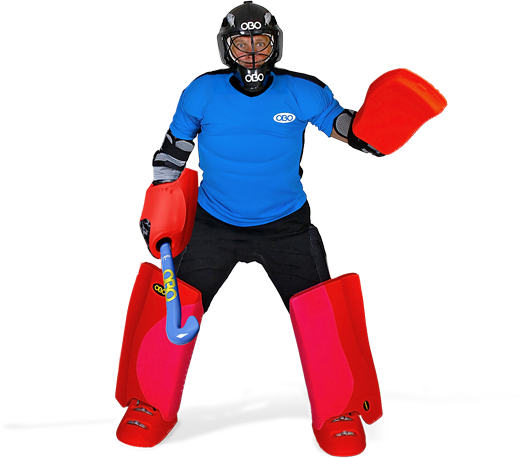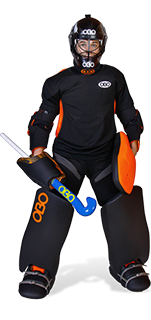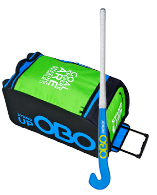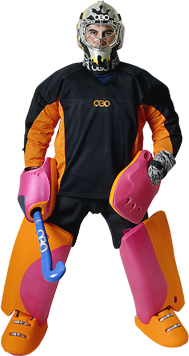KEEPERS RESOURCES

Penalty Strokes
I am often asked questions like the following: Can you please send me information on strokes. I am a goal keeper and had a stroke against me on Wednesday and I missed it. I think it was probably because I didn’t dive but rather reached out for it with my leg. How do I know when to dive or how, and how do I read them so that I can at least dive in the right direction. Can you also tell me how to build up my confidence on diving so that I can dive correctly.
Penalty strokes, mention the words and depending on your experiences, you either love them or hate them. You either won the game or lost it, all on the whim of an umpire and the push of the ball. It’s never that simple, and neither are strokes. Penalty strokes are a part of the game and a keeper has to deal with them. The problem is how. For most questions there are absolute answers. Penalty strokes are one of the least absolute parts of the game, especially when it comes to how to deal with them. For every absolute, I can think of a dozen exceptions.
First off, there is no one way to deal with strokes and the more information you can assemble, the more tools you have for dealing with them. Rachel has a tip on penalty strokes and it has a lot of relevant information. In our tips, we share experiences as players and coaches. You have your own experiences and the opportunity to learn from the keepers you play against and the strokers you’ve faced. Take advantage of them all to develop the best plan for you.
These are some of the tools I’ve used to try to be successful with penalty strokes. Note the word “try.” A penalty stroke is a severe penalty awarded for an intentional foul inside the circle or a foul that prevents a certain goal. The penalty is not designed to give the fouled team a good chance to score. It’s designed to give them an excellent chance to score. A well taken penalty stroke should go in. Having said that, not every penalty stroke is well taken and even the well taken stroke can be saved.
Knowledge is a tool and dealing with penalty strokes starts with knowing the rules and procedures for the taking of a stroke. The penalty stroke is a flick or push taken from seven yards away from the goal. The stroker is allowed one step to take the stroke. The stroker must start with both feet behind the stroke mark when setting up to take the stroke. The player may not hit, slap or drag-flick the ball. The drag flick modification is a recent change in response to players slinging the ball in closer than seven yards when they release the ball off their stick. The stroker may only touch the ball once while taking their stroke.
Proper procedure calls for the umpire to “confirm” that stroker and keeper are ready. The check can be verbal or simple visual contact. If for some reason, you’re not “ready” when the stroke is about to be taken, make sure the umpire knows it by saying “no,” or raising your hand. Umpires are not sympathetic to time-wasting, but there are legitimate reasons to step off the line. Once it’s established both keeper and stroker are ready, the umpire will blow the whistle for the stroke to be taken. The stroker does not have to take the stroke as soon as the whistle is blown, but there can not be an excessive delay between the whistle and the stroke.
Rules that pertain to the keeper are that the keeper must stand on the goal line until the stroke is taken. Standing on the goal line is interpreted as the keeper having a portion of his or her foot on or above the plane of the goal line. That means a keeper doesn’t need to stand with their toes on the goal line, he can stand with his weight on the balls of his feet slightly in front of the goal line as long as his heels are along the plane of the goal line. That’s an important distinction because it allows the keeper to cut down some angle as he extends to the sides to make a save. The keeper may not move his feet, but he doesn’t have to be motionless when the stroke is taken. The keeper can rock, shift his weight or move his hands while waiting for the stroke to be taken, as long as he doesn’t move his feet.
If the stroker violates any part of the procedure for a stroke, a 16-yard hit is awarded. Typical violations for the stroker are taking two steps on the stroke, making two touches while taking the stroke or taking the stroke before the whistle is blown. If a keeper commits a violation, a goal is awarded. The biggest violation for keepers is moving before the stroke is taken. If you have any questions about the procedures for how a stroke is to be taken, make sure you ask the umpire before getting in the goal before the stroke is taken.
While you don’t want to get in the routine of giving up strokes, having a routine for strokes is a good idea. Once a stroke is called, as a keeper it’s important to detach yourself from what’s just happened and get ready for what’s coming next. Mentally, that may be something as simple as stepping out of the goal for a second while the stroke is being set up and focusing your thoughts. Time is stopped for a penalty stroke so there’s no need to race into the goal.
In years past some keepers used the time stoppage for the stroke to put pressure on the stroker. They took their helmet off, removed their hand protectors and loosened and tightened a strap that was already fine, all in the name of “icing” a stroker. The rules don’t allow this anymore and the penalty can be a goal or a card. A keeper doesn’t want to take a stroke if he’s got a loose strap, and if you’ve got sweat in your eyes, by all means wipe your brow, but these shouldn’t be a part of your routine. My routine took maybe ten seconds and it was done while the stroke was being set up. I stepped out of the goal, took a couple of seconds to stretch and to mentally focus on the job at hand and got back in the goal ready to save the stroke.
There is a mental component to saving strokes and a lot of it comes from having confidence in your ability to save a push or flick from seven yards from goal. If you don’t believe you will save a stroke, you won’t. That’s not to say that you’ll save every stroke, but you need to believe in your ability to save the shot. A stroker knows when a keeper believes in himself. He sees it in your stance, he sees it in your eyes and he sees it in how you step up for the stroke. A keeper’s routine and approach to the stroke have to be natural. You have to believe in what you’re doing. A stroker can tell the difference between a keeper standing in goal and a keeper set to save a stroke.
We’ve talked a little about where to stand on the goal line when setting up for the stroke (heels above the goal line), but once you get past that there are different philosophies on stances for saving a stroke. The best stance for you will depend on the level you play at, your size and your reaction time. There is a big difference between the strokes taken in an Olympic final stroke off and what you might see at an under-12 game. How you stand is influenced by what you’re expecting.
As a keeper, while I believed that I could save any stroke, my primary goal was to save the savable. As I mentioned before, well taken strokes should go in. The stroke I don’t want to allow is the poorly taken one. Saving the savable should keep a keeper in a stance fairly close to his normal ready position. Typically, that’s with your feet shoulder width apart so you can explode to either side, with your weight on the balls of your feet, knees and waist slightly bent. You want to be in a position that allows you the best opportunity to react to any shot at goal.
A stance for strokes, weight and hands forward, the keeper is ready to explode
to the ball.
Stance will effect how a keeper can save a ball and going back to philosophies, it’s a matter of what you’re trying to save. Many keepers ask whether it is better to dive or go with their legs to make saves on low shots to the corners. How you set up in your stance will dictate the save you can make. I found I was most effective saving strokes by playing in a compact, explosive stance. The stance allowed me to dive down and out to get to shots to the low corners. I had the size and reactions to be able to get to the high corners.
I play with my hands very forward in my ready position. I find that having my hands forward and somewhat close together helps me with diving because my weight is forward. I’m looking to go to the ball with my hands, even shots to the low corners. My goal is to attack the ball and get out to the stroke. By trying to make the save as early as possible, I take away angle as I extend to the side. That means I don’t have to get as wide and lessens the chance of the stroke hitting me and deflecting in (particularly with my stick).
The distance between your feet in your stance will also dictate how you can react to the ball. Keepers with their feet close together often fall to the ball as they don’t have a base to push off to the ball. Keepers with their feet very wide usually end up flopping to the ball. Either way, these keepers usually end up diving to balls in the corners. If they’re successful saving, there’s nothing wrong with the stance.
Another school of thought has that the keeper should look to make himself big. He’ll carry his arms out in a fairly upright stance trying to fill as much of the goal as he can. At higher levels of play, particularly with strokers who can stroke hard and high, this can be an effective tactic. In this stance, the keeper is looking to reduce the distance he has to react to the shot because he’s made himself big. The keeper is basically looking to drop to get to shots to the low corners and stepping to reach shots to the high corners.
The keeper making themself big, hands are outside the body.
A big part of saving strokes is knowing how you can save a shot when it’s taken to a particular spot on goal. That comes from repetition. Strokes low to a keeper’s right can be saved with a foot or a stick, low to the left can be saved with a hand or a foot, high right with a stick or a hand, etc. For younger keepers, it’s often useful to train by having them save strokes where they know where the ball is going. They need to learn the mechanics of saving, whether that’s by reaching with their legs or diving. Until a keeper makes a save on a stroke, they don’t know which way is best for them. By training with strokes taken to a known spot, the keeper is provided with that opportunity and is allowed to train the reaction.
A diving save to the keeper’s left
A stick save, low to the keeper’s right
A stick save, high to the keeper’s right
As I mentioned, what stance is best for you will depend on the strokers you face, your size and speed. A smaller keeper physically can’t get to low shots to the corners with his legs, he’s going to dive which is going to require an explosive stance. A slower keeper won’t have the reactions to be as explosive and will have to make himself big. There is room for variation within the stance. It isn’t one or the other. A keeper develops the stance that works for them based on experience and experience means trying different things.
Prepare for frustration when you’re trying new things with stance on strokes. For many keepers, strokes are uncomfortable to start off with. I can’t count the number of times I’ve seen a keeper go back to their old ways after trying a new stance for a whopping three strokes in practice. Be prepared to try something for a month, for a hundred strokes, for as long as it takes to get comfortable with it and then make an evaluation based on fact, not feel.
As a coach, there are a number of things to consider when training for strokes. Is the training for the keeper, or the stroker? When training a keeper for strokes, part of the training is building confidence. Confidence comes with saves and success, something most strokers don’t want to give a keeper. Fatigue and frustration can also affect a keeper’s confidence. Have a plan for what you want and how you’re going to get it. Also be prepared to have a back up plan if practice becomes negative.
Finally, a note on “guessing” on strokes; a keeper should avoid guessing on strokes. I might anticipate where a stroker is going, but I need to base that anticipation on prior knowledge. At higher levels of play, scouting is an important part of game preparation. It entails having knowledge of who an opponent’s strokers are, how they set up and where they shoot. I may set up differently if I know where a stroker goes. I may anticipate where they shoot, but I still need to react to the ball. Just as you might have information on a stroker, he’s just as likely to have information on your tendencies.
I hear keeper’s say that if a stroker looks one way, or sets their feet up a certain way, he’ll shoot to this spot. For every one of these certain cues, I’ve seen a stroker go a completely different place. Nothing is more disheartening to a team than to have a stroker push the ball in the middle of the goal as you’re diving to the corner. My experience has been that when I focused on the ball and not the stroker, I had the most success saving the stroke.
Like any goal shot, great strokes will go in, average strokes shouldn’t. As keepers we don’t like to concede anything, but if we take the approach that we’re going to save the savable we go a long way to making strokes more manageable. Penalty strokes are nothing more than a push from seven yards. Practice them, get comfortable with them and deal with them.
Good luck,
Jon
e-mail Jon
Please note that OBO together with Jon O’Haire hold copyright over any material appearing on tips pages. We welcome the printing and distribution of these tips, provided that they are not sold, or used for financial gain. This paragraph must appear on all printed or distributed copies. The photographs above must not be used in any form without express permission from Jon O’Haire.
Comments
Leave Your Comments Below















